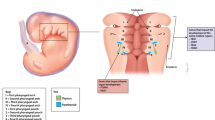Abstract
Complete DiGeorge anomaly is characterized by athymia, congenital heart disease, and hypoparathyroidism. This congenital disease is fatal by age 2 years unless immune reconstitution is successful. There are multiple underlying syndromes associated with complete DiGeorge anomaly including 22q11 hemizygosity in approximately 50%, CHARGE association in approximately 25%, and diabetic embryopathy in approximately 15%. Approximately one-third of patients present with rash and lymphadenopathy associated with oligoclonal “host” T cells. This condition resembles Omenn syndrome. Immunosuppression is necessary to control the oligoclonal T cells. The results of thymus transplantation are reported for a series of 50 patients, of whom 36 survive. The survivors develop naïve T cells and a diverse T cell repertoire.








Similar content being viewed by others
References
Conley ME, Beckwith JB, Mancer JF, Tenckhoff L. The spectrum of the DiGeorge syndrome. J Pediatr. 1979;94(6):883–90.
Hong R. The DiGeorge anomaly. Clin Rev Allergy Immunol. 2001;20(1):43–60.
Bastian J, Law S, Vogler L, Lawton A, Herrod H, Anderson S, et al. Prediction of persistent immunodeficiency in the DiGeorge anomaly. J Pediatr. 1989;115(3):391–6.
Driscoll DA, Budarf ML, Emanuel BS. A genetic etiology for DiGeorge syndrome: consistent deletions and microdeletions of 22q11. Am J Hum Genet. 1992;50(5):924–33.
Pagon RA, Graham JM Jr, Zonana J, Yong SL. Coloboma, congenital heart disease, and choanal atresia with multiple anomalies: CHARGE association. J Pediatr. 1981;99(2):223–7.
Blake KD, Davenport SL, Hall BD, Hefner MA, Pagon RA, Williams MS, et al. CHARGE association: an update and review for the primary pediatrician. Clin Pediatr. 1998;37(3):159–73.
Markert ML, Devlin BH, Alexieff MJ, Li J, McCarthy EA, Gupton SE, et al. Review of 54 patients with complete DiGeorge anomaly enrolled in protocols for thymus transplantation: outcome of 44 consecutive transplants. Blood. 2007;109(10):4539–47.
Wang R, Martinez-Frias ML, Graham JM Jr. Infants of diabetic mothers are at increased risk for the oculo-auriculo-vertebral sequence: a case-based and case–control approach. J Pediatr. 2002;141(5):611–7.
Gosseye S, Golaire MC, Verellen G, Van Lierde M, Claus D. Association of bilateral renal agenesis and Di George syndrome in an infant of a diabetic mother. Helv Paediatr Acta. 1982;37(5):471–4.
Markert ML, Alexieff MJ, Li J, Sarzotti M, Ozaki DA, Devlin BH, et al. Complete DiGeorge syndrome: development of rash, lymphadenopathy, and oligoclonal T cells in 5 cases. J Allergy Clin Immunol. 2004;113(4):734–41.
Selim MA, Markert ML, Burchette JL, Herman CM, Turner JW. The cutaneous manifestations of atypical complete DiGeorge syndrome: a histopathologic and immunohistochemical study. J Cutan Pathol. 2008;35(4):380–5.
21CFR1271 F. Guidance for Industry, August 2007, Eligibility determination for donors of human cells, tissues, and cellular and tissue-based products (HCT/Ps). 2007.
Food and Drugs (Title 21); Chapter I – Food and Drug Administration, Department of Health and Human Services; Subchapter L – Regulations under certain other acts administered by the Food and Drug Administration, Part 1271 Human Cells, Tissues, and Cellular and Tissue-based products, Code of Federal Regulations, 2008.
Markert ML, Devlin BH, McCarthy EA, Chinn IK, Hale LP. Thymus transplantation. In: Lavinin CMC, Morandi U, Schoenhuber R, editors. Thymus gland pathology: clinical, diagnostic, and therapeutic features. Milan: Springer-Verlag Italia; 2008. p. 255–67.
Markert ML, Devlin BH, Chinn IK, McCarthy EA, Li YJ. Factors affecting success of thymus transplantation for complete DiGeorge anomaly. Am J Transplant. 2008;8(8):1729–36.
Rice HE, Skinner MA, Mahaffey SM, Oldham KT, Ing RJ, Hale LP, et al. Thymic transplantation for complete DiGeorge syndrome: medical and surgical considerations. J Pediatr Surg. 2004;39(11):1607–15.
Markert ML, Li J, Devlin BH, Hoehner JC, Rice HE, Skinner MA, et al. Use of allograft biopsies to assess thymopoiesis after thymus transplantation. J Immunol. 2008;180(9):6354–64.
Markert ML, Alexieff MJ, Li J, Sarzotti M, Ozaki DA, Devlin BH, et al. Postnatal thymus transplantation with immunosuppression as treatment for DiGeorge syndrome. Blood. 2004;104(8):2574–81.
Smith CA, Driscoll DA, Emanuel BS, McDonald-McGinn DM, Zackai EH, Sullivan KE. Increased prevalence of immunoglobulin—a deficiency in patients with the chromosome 22q11.2 deletion syndrome (DiGeorge syndrome velocardiofacial syndrome). Clin Diagn Lab Immunol. 1998;5(3):415–7.
Kamchaisatian W, Wanwatsuntikul W, Sleasman JW, Tangsinmankong N. Validation of current joint American Academy of Allergy, Asthma & Immunology and American College of Allergy, Asthma and Immunology guidelines for antibody response to the 23-valent pneumococcal vaccine using a population of HIV-infected children. J Allergy Clin Immunol. 2006;118(6):1336–41.
Bassett AS, Chow EW, Husted J, Weksberg R, Caluseriu O, Webb GD, et al. Clinical features of 78 adults with 22q11 deletion syndrome. Am J Med Genet. 2005;138(4):307–13.
Shearer WT, Rosenblatt HM, Gelman RS, Oyomopito R, Plaeger S, Stiehm ER, et al. Lymphocyte subsets in healthy children from birth through 18 years of age: the Pediatric AIDS Clinical Trials Group P1009 study. J Allergy Clin Immunol. 2003;112(5):973–80.
Acknowledgments
The technical assistance of Marilyn Alexieff, Jie Li, Chia-San Hsieh, Jennifer Lonon, Julie Smith, and Anita Croasmun, and the nursing assistance of Stephanie Gupton are appreciated. The collaboration of surgeons Drs Henry Rice, Jeff Hoehner, James Jaggers, and Andrew Lodge is acknowledged. We are grateful for the clinical assistance of the faculty and fellows of the Duke Division of Pediatric Allergy and Immunology. Funding was from the National Institute of Health grants R01 AI 47040, R21 AI 60967, R01 AI 54843, M03-RR30 and from the Food and Drug Administration Office of Orphan Products Development, grant FD-R-2606. MLM is a member of the Duke Comprehensive Cancer Center. The Cancer Center flow cytometry facility under Dr. Michael Cook was very helpful for this research.
Author information
Authors and Affiliations
Corresponding author
Rights and permissions
About this article
Cite this article
Markert, M.L., Devlin, B.H., Chinn, I.K. et al. Thymus transplantation in complete DiGeorge anomaly. Immunol Res 44, 61–70 (2009). https://doi.org/10.1007/s12026-008-8082-5
Published:
Issue Date:
DOI: https://doi.org/10.1007/s12026-008-8082-5



